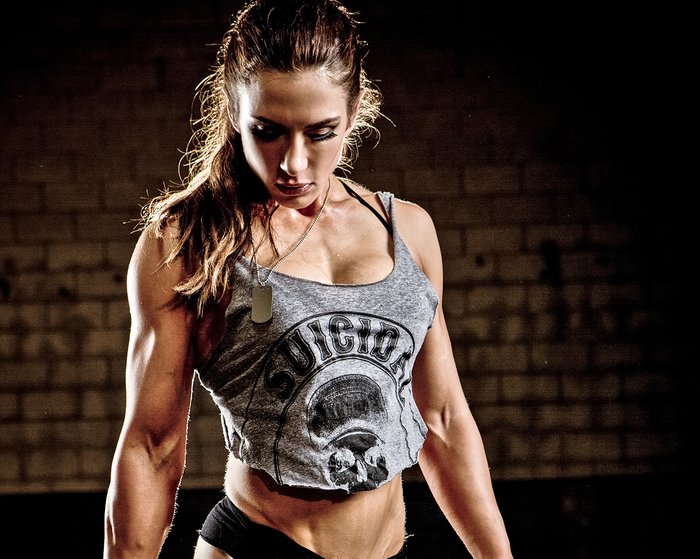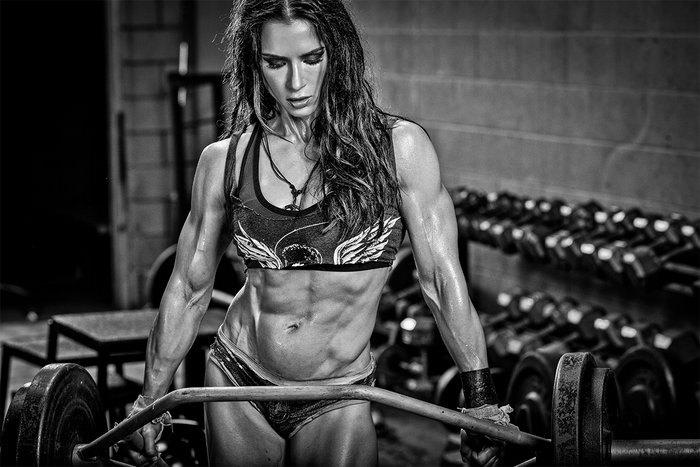It's cooler than ever for ladies to have muscle and show it off. That's music to my ears! But building it continues to be a mystery for far too many of us, and particularly for beginners.
A lot of people begin with an excess of enthusiasm and a lack of knowledge, which only leads to disappointment. They jump right into advanced training, thinking that muscle can be built quickly—it can't. Or they use too much variety, thinking they'll "confuse" their muscles into growth—they won't. One more that I guarantee will hit home for a lot of you: They hope to build muscle while their training and diet are really all about fat-loss.
So let's be clear: You can have it all, but not all at once. The key to building your very first Instagram-worthy flex isn't to reduce your enthusiasm for a better physique, but to put your effort into a long-term program that you can follow consistently. This tempered mindset will allow you to progress with your physique and keep you going for the long haul.
Here's how to make the most of your first—or latest—quest for muscle!
1. Don't Leap Into An Advanced Body-Part Split
Many advanced physique athletes use splits that are specific, to say the least. They focus on just one or two parts of the body and hammer them into submission. For the beginner, this is just a recipe to feel awful.
If you're so fatigued after a workout that you can't move the next day, you're overdoing it. On the other hand, you should have a sense that you trained—a moderate amount of muscle soreness in your target muscles—but not so much pain that it impedes your ability to train during your next workout.

If you're so fatigued after a workout that you can't move the next day, you're overdoing it.
Tip: Start with a two-day body-part split, and perform each of these twice a week for four weight-training days per week. Perform no more than two moves for any body part, and a limit of 3-4 sets per exercise. And save the dropsets and other intensity boosters for the future.
For now, just hit your reps, aiming for 8-10 per set with the last couple being somewhat of a struggle. Here's a tried and true split:
- Workout 1: Legs, abs, biceps, triceps
- Workout 2: Chest, back, shoulders
2. Eat For Muscle Growth
You may be able to get away with not eating enough when your goal is losing fat, but not when you're trying to add muscle. It's crucial to feed your body the proper nutrients so that you have plenty of energy to train, but also so your body has the raw materials necessary to build and repair muscle tissue.
This is a time to take your diet seriously. And by that, I mean eat enough, but cut out the junk. This is no time for fast food or processed carbs such as bleached flour and sugar. Emphasize lean protein sources, fruits and vegetables, slow-digesting carbs (beans and legumes, oatmeal, sweet potatoes), and healthy fats (olive and canola oil, fatty fish, and avocadoes).
Tip: To maximize muscle tissue through diet, multiply your target weight by 20 and consume that many calories per day. So if you're 115 pounds and want to weight 125, you'll need to eat 2500 calories per day (125 x 20), with about 40 percent of your total calories coming from protein.
3. Focus On Whole-Body Muscle, Not "Problem Areas"
One mistake many beginners make is to overemphasize "problem" areas in their training. This is particularly bad for newbies because they haven't trained that area enough to give it a foundation to grow from. You're more likely to cause injuries or imbalances by doing this than "bringing up" your weak spots.

For at least the first eight weeks of your training, your best bet is to focus on building muscle mass overall rather than zoning in on one underdeveloped muscle group.
This will not only increase your overall improvement, it will likely improve your area of concern better than when you target it.
Tip: Stick to the four-day-a-week, two-part split for the first eight weeks of your training. Only when you've increased muscle mass by a noticeable amount should you advance to something like a three-way weekly split.
4. Punch The Clock
While it's great to have a positive attitude, it's even more important to be dedicated and disciplined—particularly early on. Eight weeks, four workouts a week—that's 32 days you need to go get it done. Each of them is as important as any other. The same applies to your healthy meals.
Sure, you'll have days where you're not enthused about going to the gym for another leg workout or home for another meal of protein and veggies, but muscle is built through consistency. Put those words on your dashboard, your phone, or wherever else they'll really sink in. The people who get results are the ones who stay consistent day in and day out, because building muscle takes time.
Tip: Program yourself to get to the gym without considering whether or not it's what you want to do at that time. If you're truly crunched for time, find ways to shorten your workout without sacrificing effectiveness.
For instance, you can turn your 60-minute workout into a 30-minute circuit, where you hit one body part and then another without rest. Simply reduce the amount of weight you're using and keep moving. You'll find yourself huffing and puffing when you train this way, and you'll get a great workout—especially compared to the choice to skip the gym.
5. Build Muscle Mass Before You Get Ripped
When your goal is to get more muscular and ripped, you have to get more muscular first. Why? Because if you diet to shed body fat, you're likely to lose your hard-earned muscle tissue! That's the last thing you want to do.
Plus, beginners are often severely lacking in muscle mass and need it more than they realize. If they try to get ripped, they'll end up disappointed with the shape—or lack thereof—they find underneath. Remember, muscle gives a body shape. You need to add some meat to your bones!

When your goal is to get more muscular and ripped, you have to get more muscular first. Why? Because if you diet to shed body fat, you're likely to lose your hard-earned muscle tissue!
I get it—nobody wants to see the scale going up. But you have to trust the process and get comfortable with the idea of gaining now to lose later.
Tip: Don't start dieting when you reach your target weight. Gain at least 10 pounds more than the weight you want to achieve before you begin to cut calories to reduce body fat.
At the same time, you want to encourage lean tissue growth more than accretion of body fat, so keep calories moderate—again, about 20 calories per pound of your target body weight—so that you provide all the nutrients you need to add muscle tissue while keeping additional body fat to a minimum.
6. Change Things Up Once You've Earned It
Building muscle is a lifelong journey, and results accrue over time. While many fad diets and training programs target 30 days or 12 weeks or whatever, the goal is to continue to make progress.
But of course, no one follows the same program forever. Not only is that boring, but you'll begin to see diminishing results after about 8-10 weeks on the same program.

Building muscle is a lifelong journey, and results accrue over time.
Tip: After you follow the approach I've laid out for about eight weeks—maybe more if you're seeing consistent results—you should be ready to make a major change to your program. This change should reflect what's working best for you as well as what you need to do most.
For instance, you could add cardio in the form of high-intensity interval training (HIIT) between weight-training sets to encourage fat loss while maintaining muscle mass. If you want to do a fat-loss phase, cut back your calories from 20 per pound of target body weight to about 15, but don't choose too ambitious of a target! Or you could change up your weight-training exercises, focus on going heavier in a few key exercises, or move on to a three-day bodybuilding split.
Keep in mind that even the most experienced bodybuilders and fitness athletes overhaul their training about every two months so they can keep making gains, too. Some of them will do it more often than others, but for most people, 8-10 weeks per phase is the sweet spot to keep you stimulated and progressing.
Soon enough, you'll find yourself committed to this for a lifetime. Good luck!

